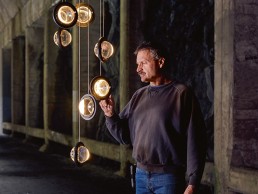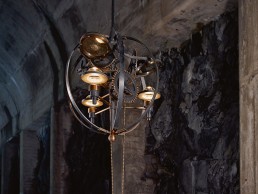
Karice Enterprises – Da Vinci Collection
Karice Enterprises introduces a unique lighting collection that brings to life centuries-old design methods.
The Da Vinci lighting collection from Karice Enterprises in Canada is inspired by one question: “If Leonardo were alive today, how would he incorporate 21st Century technology into his designs?”
Developed and manufactured in Surrey, BC, by father-son design duo Maurice and Jordan Dery, the Da Vinci collection demanded a reverence for history and a resurrection of centuries-old lighting methodology. Unlike anything the designers had created in the past, the collection’s theme revolves around machine gears, along with magnifiers that are used to intensify the light sources to mirrors, which then re-direct the light to the wall or floor.
Karice Enterprises was born in 1993 after Maurice grew tired of working for other people and while at first he concentrated on architectural metalwork for the hospitality industry it wasn’t long before he took Karice into the world of lighting.
“I was approached by Robert Clark of CLO Design in Seattle, Washington, who insisted I go into lighting,” Dery tells darc. “We had worked together for years in architectural design and fabrication and there was a market for custom lighting in restaurant chains – such as Milestones and Earls, so I made the move and it captivated me. Working with restaurant chains, conceptual sketches were supplied to me, which I would then engineer and design to be physical manifestations of the concept, while still being a fully functional fixture.”
As a child, Dery was always building and designing and had a knack for fabrication, albeit an industrial one. Born and raised in Edmonton Alberta, once Dery finished high school he followed in his father’s footsteps to become an iron-worker – advancing quickly, he was one of a few first year apprentices to climb the columns – a job usually reserved for the more experienced. While slinging iron and walking beams was a fun vocation, it was also dangerous and so he decided to switch professions to a machinist.
“In my own small way I have always related to Da Vinci,” Dery says. “He wasn’t just an ideas guy. He was a creator, a builder and it’s because of this that I have always related to him – I am both a designer and a builder. I was trained as a craftsman; I am an ironworker and a machinist. But at the same time, I have always been an inventor, with an unquenchable passion to create challenging, awe-inspiring pieces. Call it ‘functional art’ if you will.
“I have a mind for innovative, efficient engineering. For decades, that’s what people have come to me for. But at heart, I am a traditionalist. I have great respect for the past and the classics. I believe this is what we see when studying the life of Da Vinci. He wasn’t only a forward-thinker, he had a firm hand on the past, which is why he was so effective in helping bridge the gap between the Medieval and industrial worlds.”


Using the latest in lighting, machining and metalwork technology, the Da Vinci collection brings the Italian Renaissance back to life, in avant-garde form. “The Leonardo 1482 is like nothing ever seen,” Dery says. “It very much reflects the Renaissance era, but uses technology that wasn’t in existence even a few years ago. The same way Da Vinci used magnifiers and mirrors to project candlelight; we’re projecting energy-efficient LED light through a magnifier, onto a mirror, which then transfers onto a wall, ceiling or floor. The methodology is identical… the technology, 500 years apart.”
Honouring the Renaissance tradition required months of historical research from Dery, which was followed by extensive prototyping and development – beginning with the design and experimentation of the intricate gear components that form the core aesthetic of the collection’s feature piece, the Leonardo 1482. This piece poetically resembles a rising sun, borrowing heavily from Renaissance-era mechanics, and is appropriately named after the year Leonardo began designing and developing his inventions. Complementing the 1482 with correlating expression and in honour of ‘Vitruvian Man’, the Vitruvian table lamp speaks to the geometric purity and deconstructed anatomy this series reveals. To complete the collection, the Infinity 1519 is an avant-garde luminaire symbolising a setting sun – notably 1519 was the year Da Vinci passed away. The ringed capsule has a seemingly endless horizon, so the sightline is infinite. It can be displayed as a hanging pendant or suspended within a half-moon table lamp. Together, the corresponding pieces honour the story of history’s greatest designer – a mechanically minded, artisan inventor.
Be it nature or his industrial background, Dery’s designs always flow from something tangible in life. The Da Vinci collection makes use of brass and aluminium – brass for its undeniable old world look and aluminium because of its lightweight characteristics. Making sure the light is interactive was a big part of the design process and as such required moving parts – in Da Vinci’s day; he used spoked gears versus modern day involute gears.
“One of the challenges was trying to get the spokes on the wheels to mesh properly,” says Dery. “Unlike modern gears that mesh very well, we had many trials to get the gearing to function. The finish of the aluminium was a challenge also. Typically we might powder coat, or anodize the aluminium in our fixtures. This wasn’t a finish we were looking for, so a hand applied antiquing solution was used to give the look of old black iron straight from the forge.
“The brass was antiqued with a similar solution to give it that old world appearance. The illumination of the light is where the use of modern-day technology really came into play though.
“Uniquely designed COB holders had to be custom machined out of aluminium and brass. Using vintage styled magnifying glass, the COB shines up onto a magnifier, which is then directed to the mirrors. The main chandelier was the zenith of all these aspects wrapped into an elegant framework of world design and radiant modern technology.
“A simple pull of the brass chain moves eight spoked gears simultaneously to adjust the mirrors and re-direct the light onto the walls or the floor – all of this making it an elegant, interactive, and fully functional lighting fixture.
“At Karice, we believe as per Steve Job’s quote on design ‘Most people make the mistake of thinking design is what it looks like. People think it’s this veneer – that the designers are handed this box and told – make it look good – that’s not what we think design is. It’s not just what it looks like and feels like. Design is how it works. So it’s the same with lighting. Much design work must go into the process of creating a light.
“Back in the day, the lighting was all incandescent. The warm glow of incandescent is hard to replicate with today’s LED technology, although the LEDs are improving continuously. LEDs have been a game changer for lighting design. Without this modern innovation, the designs of today wouldn’t be possible. Giving more freedom into the form of the design lets us play with the new dimensions and aspects of the art of illumination. Everything we see and do is affected by light – our mood, our thought patterns, even how we interact with others. Lighting can make or break the ambience and design of a space. Lighting almost seems alive to us here at Karice. Consequently that’s where I end up drawing my design inspiration from, life itself.”
With the Da Vinci collection, Dery knew from the beginning and was clear in his mind – that he wanted to create something different from everything else in existence, something that had never been done before.
“I wanted it to be complicated, because I wanted to show the world that Karice can design and create lighting fixtures that are popular in today’s market – but not everyone can design and create the Da Vinci Collection. I wanted to show the modern world that lighting can be more than a light source on a stick.”



